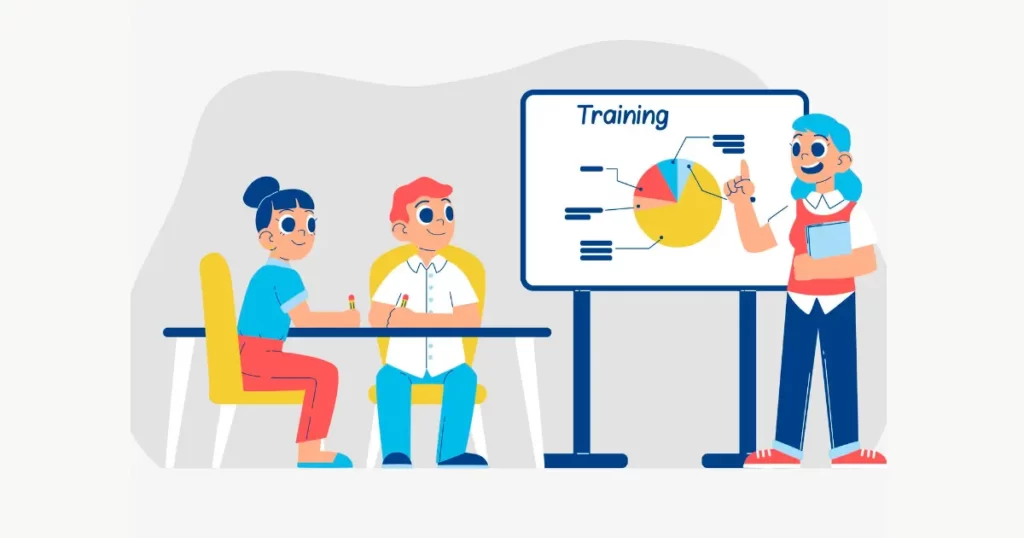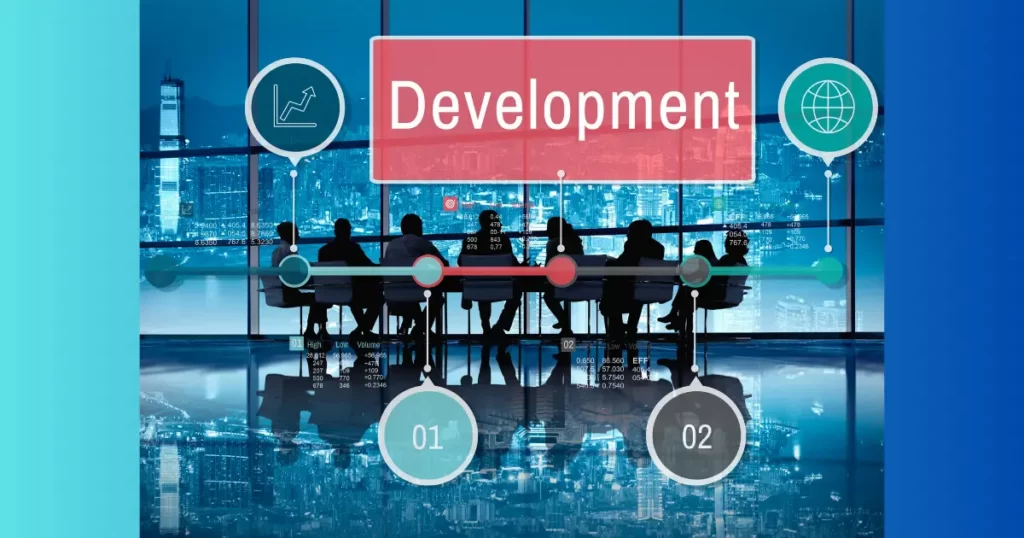Introduction
In today’s dynamic business environment, where companies strive to gain a competitive edge, the significance of effective training & development in HRM cannot be overstated. Organizations that invest in their employees’ growth and skills enhancement are more likely to succeed and thrive.
However, implementing successful training programs can pose challenges for organizations, from budget constraints to resistance to change. This guide will navigate through these challenges and shed light on the secrets to achieving successful training and development in HRM.
Table of Contents
Understanding the Role of Training and Development
Defining the Terms ‘Training’ & ‘Development’
Training & development are often used interchangeably, but they have distinct meanings in the context of Human Resource Management. Training refers to the process of imparting specific skills and knowledge to employees, usually related to their current job roles. On the other hand, development focuses on long-term growth and preparing employees for future roles through broader skill development and career advancement opportunities.
Differentiating between Training & Development in HR Management
While both training & development are integral components of HRM, it is crucial to understand the differences to maximize their effectiveness.
Training primarily focuses on immediate job requirements, enhancing existing skills, and addressing specific deficiencies.
Development, however, aims to cultivate a holistic growth mindset among employees by nurturing leadership abilities, fostering critical thinking, and building a talent pipeline for future organizational needs.
Importance of Aligning Training & Development with Organizational Goals
To achieve the desired outcomes, it is vital to align training & development initiatives with the overall organizational goals.
By integrating these programs with strategic HR planning, organizations can ensure that employees’ skills and competencies are in line with the company’s long-term vision.
Such alignment enhances workforce capabilities, promotes employee engagement, and drives organizational success.
Integrating Training & Development with Strategic HR Planning
Linking training & development initiatives with strategic HR planning forms the foundation for effective programs. This integration leverages HRM practices to achieve organizational objectives and optimize employee performance.
By incorporating training needs assessment in strategic planning, organizations can identify skill gaps, prioritize training resources, and create tailored programs to address specific organizational needs.
Identifying Training Needs

Understanding the training needs of employees is vital for designing relevant and impactful programs. This process involves various methods, including:
- Conducting skill gap analyses: By assessing the existing skills and competencies of employees, organizations can identify areas that require improvement or further training.
- Assessing performance deficiencies: Analyzing employee performance evaluations and feedback can help identify gaps in knowledge, skills, or behaviors that need to be addressed through training and development programs.
Designing Effective Training Programs
Designing effective employee training and development programs is a pivotal component of successful HRM. To achieve this, organizations must focus on:
Defining Learning Objectives
Clearly defined learning objectives are essential for structuring training programs. These objectives guide the development of content and ensure that the training aligns with desired outcomes.
They provide employees with a clear understanding of what they should gain from the training and motivate them to actively engage in the process.
Selecting Appropriate Training Methods
Choosing the right training methods in HRM is crucial to cater to diverse learning styles and preferences.
Depending on the organization’s needs, training methods can range from classroom training and instructor-led initiatives to on-the-job training, e-learning, online training platforms, mentoring, and coaching programs.
This diversity creates a dynamic learning environment and maximizes employee engagement.
Creating Engaging and Interactive Training Materials
Engaging and interactive training materials enhance the learning experience and improve knowledge retention.
Organizations can utilize multimedia resources, real-life scenarios, case studies, and interactive exercises to foster a stimulating and hands-on training environment.
Incorporating technology, such as augmented reality or gamification, can further enhance the effectiveness of training materials.
Incorporating Technology in Training Delivery
Technology is revolutionizing training & development in HRM. Organizations can leverage learning management systems (LMS), virtual classrooms, online modules, and mobile applications to deliver training anytime, anywhere.
This flexibility enables employees to access training materials at their convenience and promotes self-paced learning.
Implementing Training Programs
Implementing training programs necessitates careful planning and execution. Organizations should consider the following:
Formulating Effective Training Schedules and Timelines
Creating a well-structured training schedule and timeline is crucial to ensure that employees can participate without disrupting regular workflow. It allows organizations to allocate the necessary time for training sessions while minimizing the impact on daily operations.
Ensuring Proper Resource Allocation
Adequate resource allocation, including trainers, training facilities, materials, and technology, is essential for the successful implementation of training programs.
Organizations should ensure that they have the necessary resources in place to deliver effective training sessions and provide a conducive learning environment.
Managing Logistics and Facilities for Training Sessions
Efficient logistics management is critical to the smooth execution of training programs. Organizations should consider factors such as venue selection, travel arrangements, accommodation, catering, and technological support to create a seamless training experience for participants.
Leveraging Different Training Methods

To cater to diverse employee needs and preferences, organizations should leverage a mix of training methods. Some commonly used methods include:
Classroom Training and Instructor-led Initiatives
Classroom training allows for face-to-face interactions between trainers and employees, promoting active learning and immediate feedback. It provides a structured environment for skill development and knowledge acquisition.
On-the-Job Training and Apprenticeships
On-the-job training in HRM immerses employees in real-work situations, allowing them to acquire skills and knowledge while performing their regular job duties.
Apprenticeships provide a structured on-the-job training experience, typically for more complex or specialized roles.
E-learning and Online Training Platforms
E-learning and online training platforms in HRM offer flexibility and accessibility for employees to acquire knowledge and skills remotely.
They provide interactive modules, virtual classrooms, and self-paced learning options, catering to diverse learning styles.
Mentoring and Coaching Programs
Mentoring and coaching programs facilitate the transfer of knowledge and skills from experienced employees to less experienced ones.
These programs provide guidance, support, and personalized developmental opportunities, fostering a culture of learning and growth within the organization.
Encouraging Employee Participation and Engagement
Creating a supportive training environment and actively encouraging employee participation are key factors in successful training and development. Organizations can promote participation and engagement by:
- Establishing a safe and inclusive environment where employees feel comfortable asking questions and sharing their thoughts.
- Motivating employees through clear communication about the benefits of training, its relevance to their roles, and the potential career growth opportunities it offers.
- Recognizing and rewarding employees for their participation and progress in training programs, fostering motivation and a positive learning culture.
Monitoring and Evaluating Training Effectiveness
To gauge the effectiveness of training programs in HRM, organizations need to establish evaluation criteria, metrics, and systematic processes. This allows them to:
- Conduct pre- and post-training assessments to measure knowledge and skill improvement.
- Collect participant feedback through surveys or interviews to gather qualitative insights that can inform program enhancements.
- Analyze and interpret training data to identify trends, strengths, and areas for improvement, enabling organizations to make data-driven decisions and continually enhance training initiatives.
Addressing Challenges in Training and Development
Successful leadership training and development initiatives may encounter challenges that organizations must address. Some common challenges include:
Overcoming Resistance to Change
Change can be met with resistance, particularly when implementing new training initiatives. Organizations can mitigate resistance by fostering a culture of openness and communication, involving employees in the decision-making process, and showcasing the benefits of training to individual and organizational growth.
Dealing with Budget Constraints
Budget constraints can limit the resources allocated to training and development. However, organizations can explore cost-effective alternatives such as leveraging technology for e-learning, utilizing in-house trainers, or partnering with external training providers to optimize training outcomes within budgetary limits.
Addressing Training Biases or Discrimination
Organizations must ensure that training programs are free from biases or discrimination. This entails designing inclusive training content, providing equal opportunities for all employees, and continuously monitoring training sessions to promote fairness and diversity.
Adapting Training Programs for Diverse Employee Backgrounds
Diverse employee backgrounds require training programs that cater to different learning styles, languages, and cultural sensitivities. Organizations should embrace diversity and tailor training initiatives to accommodate employees’ unique needs, fostering an inclusive and equitable learning environment.
Measuring Return on Investment (ROI) in Training and Development
Calculating the ROI of training and development programs for employees enables organizations to measure the financial impact and justify their investments. To measure ROI, organizations can:
- Assess the cost savings or revenue generated due to improved employee performance after training.
- Compare the value of increased productivity and efficiency against the costs associated with training programs.
- Demonstrate the qualitative benefits, such as improved employee satisfaction and reduced turnover, that result from effective training.
Sustaining Continuous Development

To maximize the benefits of training and development of employees, organizations should focus on sustaining continuous development. This involves:
- Developing a culture of lifelong learning where employees are encouraged to enhance their skills continuously.
- Providing ongoing opportunities for skill enhancement, such as workshops, seminars, or conferences.
- Offering career development and growth opportunities that enable employees to apply their newly acquired skills and advance within the organization.
Conclusion
Successful training & development in HRM play a vital role in enhancing employee performance, fostering a culture of learning, and driving organizational success.
By aligning training initiatives with organizational goals, identifying training needs, designing effective programs, leveraging various training methods, encouraging employee participation, evaluating effectiveness, addressing challenges, measuring ROI, and sustaining continuous development, organizations can unlock the secrets to achieve remarkable outcomes in human resource management.
FAQs
What is the difference between training & development in Human Resource management?
Training focuses on immediate skill enhancement for current job roles, while development aims for long-term growth, preparing employees for future roles.
How can organizations identify the training needs of their employees?
Organizations can identify training needs by conducting skill gap analyses, assessing performance deficiencies, and seeking feedback from employees and supervisors.
What are different methods of delivering training programs?
Different training methods include classroom training, on-the-job training, e-learning, online platforms, mentoring, and coaching programs.
How can organizations measure the effectiveness of their training programs?
Organizations can measure training effectiveness by conducting pre- and post-training assessments, collecting participant feedback, and analyzing training data.
How can HR professionals overcome resistance to change during training implementation?
HR professionals can overcome resistance to change by fostering a culture of openness, communicating the benefits of training, involving employees in decision-making, and addressing concerns.
How can organizations calculate the ROI of their training and development programs?
Organizations can calculate ROI by assessing cost savings, comparing productivity gains against training costs, and demonstrating qualitative benefits, such as improved employee satisfaction.
How can continuous development be sustained within an organization?
Continuous development can be sustained by fostering a culture of lifelong learning, providing ongoing skill enhancement opportunities, and offering career development and growth prospects.